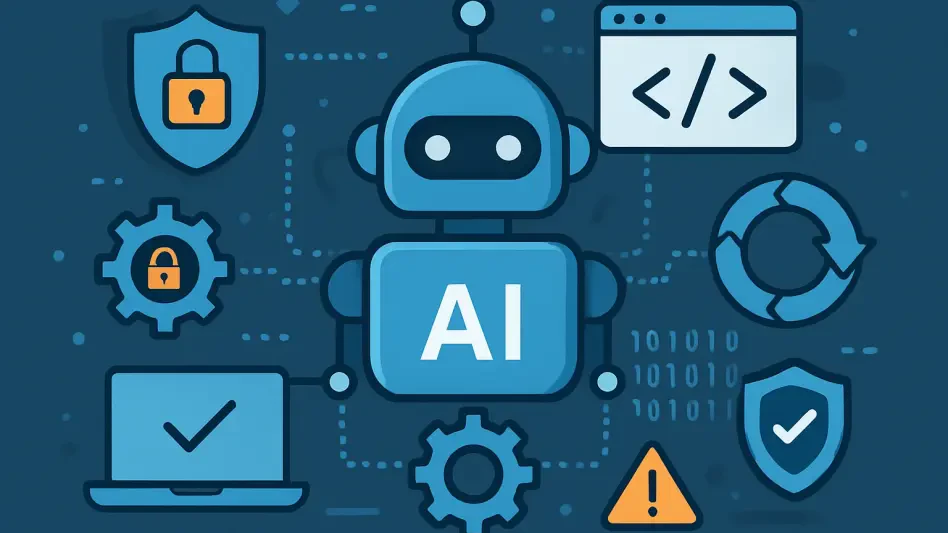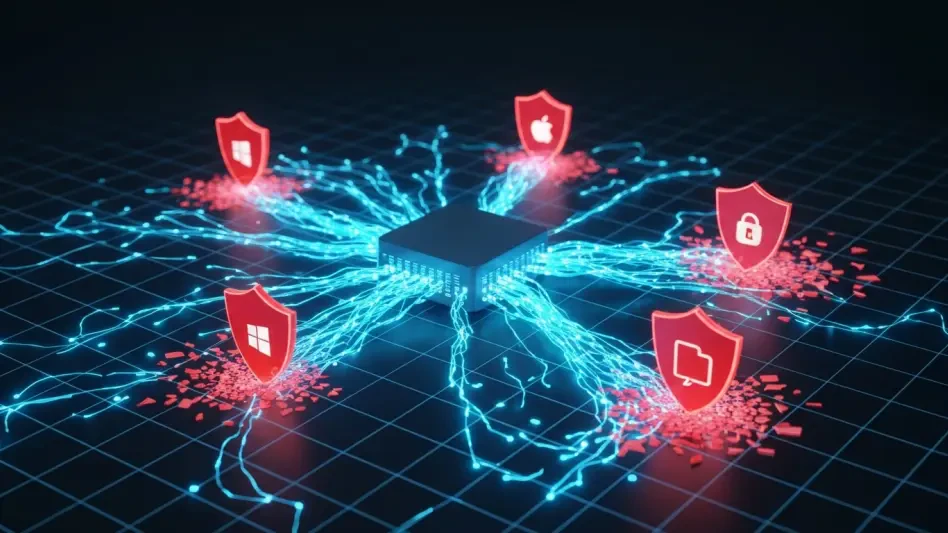In an era where software development races against ever-tightening deadlines and escalating cyber threats, the integration of security throughout the development lifecycle has become non-negotiable. DevSecOps, a methodology that merges development, security, and operations, aims to embed protective measures from the very start, ensuring vulnerabilities don’t sneak through to deployment. Yet, despite its potential, many organizations grapple with implementing this approach effectively, often hindered by manual processes, siloed teams, and complex pipelines. Artificial intelligence (AI) is emerging as a powerful ally, offering automation and advanced threat detection to streamline workflows and bolster defenses. By addressing persistent challenges with precision and speed, AI is reshaping how teams approach secure software creation. This exploration delves into the transformative impact of AI on DevSecOps, highlighting its role in overcoming barriers, enhancing collaboration, and ensuring safer releases in a landscape where every second—and every line of code—counts.
Unpacking the DevSecOps Framework and Its Hurdles
DevSecOps represents a cultural and technical shift, advocating for security to be woven into every phase of software development rather than tacked on at the end. Known as “shifting left,” this approach integrates tools like static code analysis and container scanning into Continuous Integration and Continuous Deployment (CI/CD) pipelines, fostering collaboration across developers, security experts, and operations staff. Prominent organizations, from Wipro to the US Department of Defense, have adopted this framework to secure cloud environments and modernize legacy systems. However, the journey is far from smooth. Many teams face resistance from leadership, struggle to demonstrate tangible returns on investment, and find themselves bogged down by the sheer complexity of aligning diverse workloads with stringent compliance requirements. These obstacles often result in security gaps that expose systems to risks, underscoring the need for innovative strategies to make DevSecOps not just a concept, but a practical reality in high-stakes environments.
Challenges in executing DevSecOps effectively are well-documented, with studies revealing persistent misunderstandings of its core principles. A notable 2023 survey by Progress Software highlighted that numerous organizations lack the depth of knowledge required to prioritize security initiatives or meet audit standards like GDPR and PCI DSS. This knowledge gap often leads to delayed responses to vulnerabilities, as teams struggle to integrate security practices early enough in the process. Compounding the issue is the difficulty in managing diverse and evolving tech stacks, where traditional methods fail to keep pace with rapid deployment cycles. The result is a frustrating cycle of reactive fixes rather than proactive prevention, leaving software supply chains and cloud infrastructures exposed to sophisticated attacks. As the demand for faster releases intensifies, finding a way to bridge these implementation gaps without sacrificing security becomes paramount for organizations aiming to stay competitive and protected in a digital-first world.
AI as a Catalyst for Streamlined DevSecOps Workflows
Artificial intelligence is stepping into the DevSecOps arena as a transformative force, particularly through its ability to automate repetitive and labor-intensive tasks. Processes such as vulnerability scanning, code reviews, and compliance monitoring, which often consume significant time and resources, can now be handled with remarkable efficiency using AI-driven tools. Solutions like Darktrace PREVENT and Qualys VMDR enable teams to identify risks, rank their severity, and even propose remediation steps in near real-time. This reduction in manual workload allows developers and security professionals to focus on higher-value activities, such as designing robust architectures or crafting strategic defenses. By embedding automation into CI/CD pipelines, AI not only accelerates development cycles but also minimizes the human errors that frequently lead to overlooked flaws, paving the way for more reliable software releases under tight deadlines.
Beyond basic automation, AI’s impact on DevSecOps extends to enhancing the scalability and adaptability of security practices across complex environments. Tools like CrowdStrike Falcon and Tanium exemplify how AI can manage patch deployment by detecting vulnerabilities and rolling out updates with minimal human intervention. This is particularly critical in cloud-based systems or microservices architectures, where manual oversight becomes impractical due to sheer volume and diversity. AI’s capacity to analyze vast datasets ensures that even subtle inconsistencies are flagged before they escalate into exploitable weaknesses. Furthermore, by integrating with existing infrastructure-as-code platforms like Terraform and Ansible, AI helps embed security configurations directly into deployment scripts, reducing the risk of misconfigurations that often lead to breaches. This seamless alignment with modern workflows positions AI as an indispensable tool for organizations striving to maintain agility without compromising on the integrity of their systems.
Strengthening Defenses with AI-Powered Threat Detection
One of the most compelling advantages of AI in DevSecOps is its prowess in proactive threat detection, a capability that traditional methods struggle to match. Machine learning algorithms excel at sifting through massive volumes of data in real time, identifying anomalies and potential breaches before they can cause significant harm. Tools such as Microsoft Security Copilot and SentinelOne aggregate security logs and system metrics to provide early alerts, enabling rapid response to emerging risks. This forward-looking approach is invaluable in environments with intricate CI/CD pipelines or sprawling cloud setups, where threats can hide in countless layers of code or traffic. By empowering teams to address issues at their inception, AI reinforces the “shift left” ethos of DevSecOps, ensuring security evolves from a reactive afterthought into a core pillar of the development lifecycle.
AI’s role in threat detection also extends to fostering a deeper understanding of attack patterns, which enhances long-term resilience. Unlike static rule-based systems, AI adapts to evolving cyber threats by learning from historical data and current trends, offering predictive insights that help anticipate future vulnerabilities. This dynamic capability is crucial for protecting software supply chains, where third-party components often introduce hidden risks. By continuously monitoring for suspicious activity and correlating it with broader threat intelligence, AI tools provide actionable recommendations tailored to specific contexts. Such precision not only reduces false positives—a common frustration with older systems—but also ensures that security teams can allocate their efforts effectively. As cyber adversaries grow more sophisticated, leveraging AI to stay one step ahead becomes a strategic necessity for maintaining trust and stability in software ecosystems.
Balancing AI Innovation with Human Oversight
While AI offers undeniable benefits for DevSecOps, its integration must be approached with a measured perspective to avoid over-reliance on technology at the expense of human judgment. Critics have noted instances where AI-generated outputs, such as automated bug reports, can overwhelm teams with irrelevant or inaccurate findings if not properly tuned. This underscores the importance of viewing AI as a supportive tool rather than a complete replacement for skilled professionals. Striking the right balance involves configuring AI systems to handle well-defined, repetitive tasks while reserving complex decision-making for human experts who can contextualize edge cases and nuanced scenarios. For instance, while AI can flag potential code vulnerabilities with speed, it often requires a seasoned developer to assess the true impact and prioritize fixes, ensuring that automation enhances rather than hinders the overall security posture.
Maintaining this equilibrium also means investing in training and oversight mechanisms to keep AI tools aligned with organizational goals. Regular audits of AI-driven processes can help identify blind spots or biases in algorithms, preventing costly errors in high-stakes environments. Additionally, fostering collaboration between cross-functional teams remains essential, as AI can aggregate data from various sources to provide unified insights, but it’s the human element that translates those insights into actionable strategies. Encouraging dialogue between developers, security analysts, and operations staff ensures that AI’s contributions are contextualized within broader business objectives. As DevSecOps continues to evolve, the synergy between cutting-edge technology and human expertise will be the linchpin for creating secure, efficient, and innovative software solutions that withstand the test of time and threats alike.
Reflecting on AI’s Impact and Future Pathways
Looking back, the journey of integrating AI into DevSecOps revealed a landscape where persistent security challenges met groundbreaking technological solutions. Automation of tedious tasks like code scanning and patch management stood out as a pivotal achievement, significantly reducing manual workloads for teams across industries. Equally impactful was AI’s ability to detect threats proactively, using machine learning to uncover risks before they spiraled into crises. Despite these advancements, the caution against over-dependence on algorithms echoed loudly, reminding all stakeholders that human oversight remained indispensable. For the future, organizations should focus on refining AI tools to minimize false positives while investing in training programs to deepen understanding of DevSecOps principles. Establishing robust feedback loops between technology and teams will also ensure that AI continues to evolve as a trusted partner, driving safer and swifter development cycles in an ever-shifting digital terrain.








